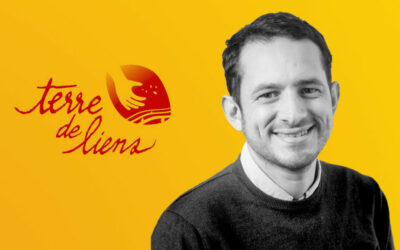Interview with Fabio Monte, Leader at QoQa
QoQa is one of the biggest players in the Swiss e-commerce market. The idea for this platform was launched in 2005 by its founder, Pascal Meyer. The concept is simple: handpicked products available for just 24 hours at unbeatable prices and with limited stock. Today, over 900,000 Swiss customers regularly shop on the community-driven online sales platform. Over 15 years, QoQa has grown and now has 180 employees. Let’s meet one of its leaders!
How did you decide to adopt Holacracy?
It was a mix of two things. We first discovered it through our agency, Liip, which was passionate about Holacracy, and also through internal advocates like Joann (leader of the circle responsible for web development). We were intrigued and started looking into it. But what ultimately pushed us to make the leap was the lack of a clear governance structure as our team grew past 100 people. This created internal challenges in defining roles and responsibilities. We also wanted to stay agile with the Scrum methodology and continue in that direction… Holacracy seemed to make that possible.
What were the positive surprises in your Holacracy adoption?
The biggest surprise was how quickly our 180 employees (yes, we grew very fast!) integrated the method. For me, the choice was obvious after more than two years of research and training. But not everyone had spent as much time on the topic. So, I was pleasantly surprised by how quickly people said, “Okay, let’s do it,” even without fully understanding the consequences.
We also received some skeptical feedback from our network—people can have reservations about making everything transparent. And, of course, there were concerns from some « leaders » who feared losing power. But I think people have now grasped the key idea: power doesn’t disappear; it becomes more distributed and accessible to everyone.
What have you implemented internally to ensure the success of this transformation?
Of course, COVID didn’t help—we’ve all been working remotely for so long… But we already had many trained employees, and that number is still growing. It’s a significant investment. The more people understand the nuances of Holacracy, the more they will champion it and persevere through challenges.
Supervision of our meetings by coaches from Ivolve and Semawe also helps us gain an overview and focus on the circles that are struggling. Having this external perspective and the ability to take timeouts helps answer questions, especially individual concerns. The key is figuring out how the system can help us solve our problems. The theory seems simple, but it’s a different story when you hit real-world roadblocks.
You created a circle dedicated to Holacracy skill development. Can you tell us more about it?
We created the QoQa Academy circle to identify the person leading the transformation. It is led by Christos, who has coordinated this project from the start—whether in selecting a partner or implementing team training.
The advantage is that everyone at QoQa knows that if they need coaching or supervision on a hot topic, they can turn to this circle for answers. This circle also serves as the link with external coaches from Ivolve and Semawe, acting as a filter to prevent everyone from directly contacting external coaches. Internal coaches can assess whether external involvement is necessary.
What makes QoQa particularly compatible with Holacracy?
I once wrote in one of our presentations:
« Everyone does what they’re good at. »
We’ve long had a culture where people could spontaneously step up to do things beyond their primary skill set. For example, Christos initially volunteered to lead Holacracy adoption, even though he’s a developer by trade.
At QoQa, people express themselves freely. Overall, the team is supportive, vocal, and proactive. With Holacracy, they can go beyond just offering feedback and actually propose solutions.
What’s the next challenge in your Holacracy journey?
There’s a lot of work ahead. I worry that our organizational design might not evolve as quickly as the rest of the company and that we might forget Holacracy, slipping back into old habits where we relied on so-called “common sense.” I see signs of this in phrases like, “We’ll add that to governance later” or in how we don’t always use the formal Holacracy meeting structures for tactical and governance sessions.
Everyone has the power to challenge governance, but some still think they can’t initiate change or take the lead in proposing modifications. We’ve encountered frustration from a few people who say, « I can’t make a change, » when they feel a need to rethink an organization. Some employees were unclear about their roles but hesitated to speak up, still expecting former leaders to take charge.
We need to ensure that everyone feels empowered to say: “I have an issue; I’ll bring it to governance. Maybe nothing will come of it, but at least it’s on the table.”
Have you noticed any changes in your team?
For me, a major change happened when I became leader of the QoQa circle. Pascal, the founder and historical “Otter in Chief”, is still very much involved, but this helped clarify and define our respective roles. It also brought more clarity to the rest of the team.
This new structure improves our operations because Pascal keeps the project aligned with QoQa’s DNA. He also plays the role of disruptor—he’s the one who shakes things up. The advantage is that when we need to innovate, I discuss it with Pascal, and when it comes to implementing it with the team, I take the lead.
As for the rest of the team, all key responsibilities have been formalized with the role of circle leader. This allows them to fully embrace their responsibilities. Before, we called them department heads, but it wasn’t clear what that actually meant. Now, I’ve seen a shift in mindset—some people feel more exposed, but for those who embrace it, it’s an opportunity to step up and assert their legitimacy.
« I’m responsible for this role. If you’re making this decision, it should involve me because I own this part of the project. »
Are there aspects of Holacracy adoption that you find more sensitive?
HR-related topics are more delicate. Even though Holacracy defines roles, there’s still a crucial link to human resources. People ask, “What’s my official title?” “What should I put on LinkedIn?” “Should I list all my roles?” I think we need to balance both worlds.
Then there’s our annual review process and economic realities like salary discussions, which impact how people perceive their identity externally.
Another sensitive point is our work on defining a vision. Even though Holacracy allows for constant evolution and iteration, like any organization, we need a clear vision. We face the challenge of engaging everyone in this process and asking, “Where do we want to go?”
QoQa has many leaders who are in their roles because they deserve them, but they’re not necessarily used to being leaders or setting a long-term vision. This kind of classic leadership coaching needs to be integrated with our Holacratic governance model.
Any final thoughts?
I’d like to share a few secrets for companies considering Holacracy:
- Fast internal communication is key.
- Involve everyone in the discussion from the start.
- Provide early hands-on examples so people grasp the approach.
At QoQa, we organized workshops before making the final decision to show people the potential benefits of this shift. And—of course—choosing the right partner is crucial. A coach shouldn’t just hand over the Holacracy rulebook; they need to understand the unique characteristics of the organization.
Holacracy isn’t just about governance; it changes how you work individually and with others. It’s a journey that makes you grow, no matter where it leads!

Juliette Brunerie
Discover other articles written by the author!
Other articles .
How QoQa Managed to Successfully Implement Holacracy Using Holaspirit
Read the articleDiscover other articles written by the author!Other articles .
How is the Grenoble Metropolis inspired by Holacracy?
Discover How Holacracy Is Influencing and Inspiring Managers in the Grenoble Metropolis. Hélène Clot, Director of Strategy, Innovation, and Citizen Relations, shares her journey and how Holacracy is addressing key challenges in the public sector today. She explains...
What does Holacracy enable in a co-directed organization? Interview with Hugo, co-director of the Terre de Liens Foundation
Hugo Arnaud, you are the Co-Director of the Foundation. Can you tell us more about your background? I joined Terre de Liens a year and a half ago and am now Co-General Director following the departure of the founder. I studied business and have always been passionate...




